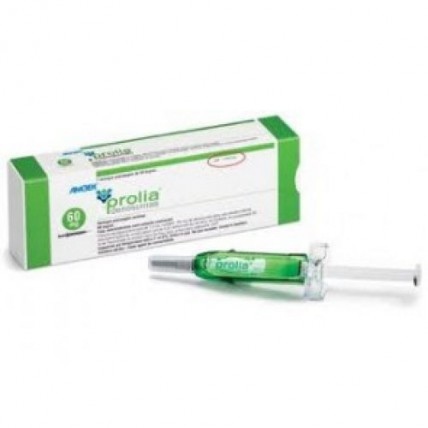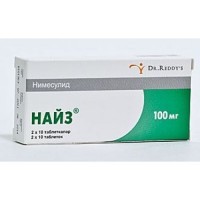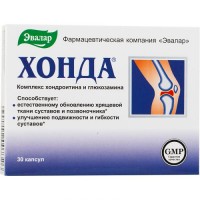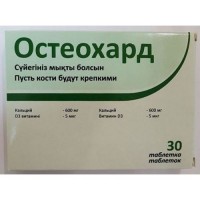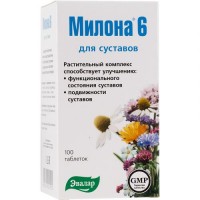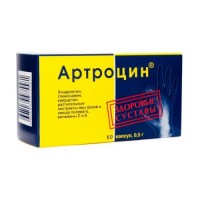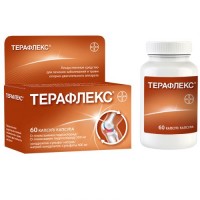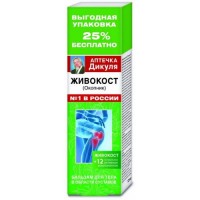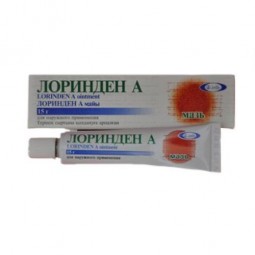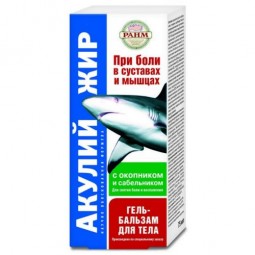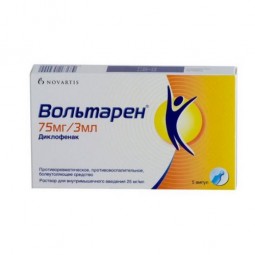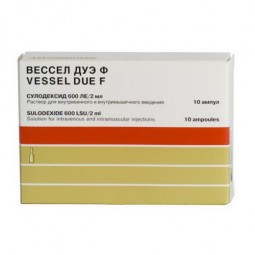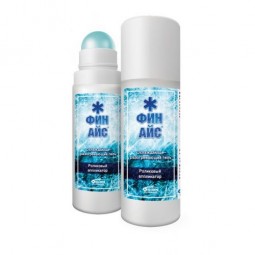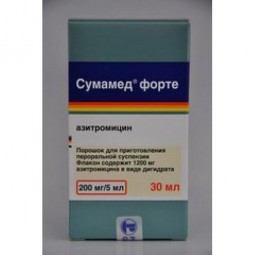Prolia 60 mg 1ml solution for subcutaneous administration
- $642.10
The instruction for medical use
of Prolia® medicine
the Trade name
of Prolia®
the International unlicensed
name Denozumab Lekarstvennaya a form
Solution for hypodermic introduction, 60 mg/ml
Structure
of 1 ml of solution contains
active agent – denozumab 60 mg,
excipients: sorbitol (E420), acetic acid ice, polysorbate 20, sodium hydroxide, water for injections.
The description
Transparent solution from colourless till light yellow color, almost free from inclusions, may contain traces of particles from translucent till white color.
Pharmacotherapeutic group
Drugs for treatment of diseases of bones. Other drugs affecting structure and a mineralization of bones. Denozumab.
The ATX M05BX04 code
the Pharmacological
Denozumab Pharmacokinetics properties is characterized by the nonlinear pharmacokinetics dose-dependent in the wide range of doses and dose-dependent increase in exposure at hypodermic introduction of a dose of 60 mg (1 mg/kg) and above.
Absorption
At hypodermic introduction of a denozumab in a dose of 60 mg (or 1 mg/kg) its bioavailability is 61%. The maximum concentration of a denozumab (Cmax) is observed in 10 days after introduction (range of 2-28 days) and makes 6 mkg/ml (range of 1-17 mkg/ml).
Metabolism
Denozumab consists of amino acids and carbohydrates as usual immunoglobulin. It is improbable that denozumab is allocated by means of hepatic metabolism. Metabolism and removal of a denozumab happens on the way of clearance of immunoglobulins of which disintegration on small peptide chains and separate amino acids is result.
Removal
After achievement of Cmax drug content in blood serum decreases with elimination half-life of 26 days (range 6-52 days) and further within 3 months (range of 1.5-4.5 months). denozumab it was not found in 53% of patients in blood serum after 6 months from the moment of the last administration of drug.
Changes of pharmacokinetic parameters of a denozumab and also cumulation for all the time of reception of repeated doses of drug on 60 mg are not observed each 6 months. The pharmacokinetics of drug was not influenced by formation of the connecting antibodies to a denozumab.
The pharmacokinetics of a denozumab has similar indicators at men and women.
The pharmacokinetics of a denozumab does not depend on disease degree (loss of bone weight or osteoporosis, oncological diseases of a prostate or a mammary gland).
The correlation between the excess body weight and concentration of medicine on the basis of indicators of AUC and Cmax was revealed. However, this correlation is not considered clinically important as the pharmakodinamichesky effects traced on markers of remodeling of a bone and increase in mineral density of a bone were invariable in the wide range of body weight. Thus, the body weight of the patient (range from 36 to 140 kg) has no significant impact on pharmacokinetics of a denozumab.
Separate groups of patients
the Age has no significant impact on pharmacokinetics of a denozumab according to analysis findings in population of patients from 28 to 87 years.
Children and teenagers (up to 18 years)
the Pharmacokinetics at children was not studied.
The race
Pharmacokinetics of a denozumab does not depend on race at women in a postmenopause and at the patients with a breast cancer who are on hormonal therapy.
Patients with a renal failure
In a research on 55 patients with various degree of renal dysfunction, including the patients who are on dialysis, degree of a renal failure did not influence pharmacokinetics and a pharmacodynamics of a denozumab therefore correction of the mode of dosing of a denozumab in chronic kidney disease is not required.
A chronic liver failure
of Researches of influence of insufficiency of function of a liver on pharmacokinetics of a denozumab it was not carried out. In general, monoclones are not removed by means of hepatic metabolism, thus, hepatic pathology does not influence pharmacokinetics of a denozumab.
The pharmacodynamics
the action Mechanism
the Drug Prolia® represents completely human monoclone (IgG2) weighing about 147 kd having high affinity and specificity to a ligand of a receptor of the activator of a nuclear factor κB (RANKL). Contacting RANKL – the transmembrane or soluble protein playing an important role in forming, functioning and survival of osteoclasts (the cells which are responsible for a resorption of a bone tissue), Prolia® interferes with activation of the only receptor of RANKL — the activator of a nuclear factor κB (RANK), located on a surface of osteoclasts and their predecessors. Thus, prevention of interaction of RANKL/RANK inhibits education, activation and lifetime of osteoclasts. As a result the drug Prolia® reduces a bone resorption and increases the weight and durability of cortical and trabecular layers of a bone.
Prescribing of the drug Prolia® in a dose of 60 mg leads Pharmakodinamichesky effects to fast reduction of serumal concentration of a marker of a resorption of a bone tissue — a 1C-telopeptid (STH) — approximately for 85% during the next 3 days. Reduction of concentration of STH remains stable in a 6-month interval between dosing. Speed of decrease in concentration of CTX in blood serum partially decreases at decrease in concentration of a denozumab in serum from the maximum level in ≥ 87% to ≥ 45% (ranging from 45 up to 80%) that reflects reversibility of influence of the drug Prolia® on remodeling of a bone. These effects were observed throughout all course of treatment. After resuming of the Prolia® drug treatment the extent of decrease in concentration of STH was similar to extent of decrease in concentration of STH at the beginning of a course of treatment denozumaby.
According to physiological interrelation of processes of education and a resorption when remodeling a bone tissue, reduction of maintenance of markers of formation of a bone (for example, bone and specific alkaline phosphatase and serumal N-terminal pro-peptide of collagen I of type) from first month after introduction of the first dose of the drug Prolia® was observed. After completion of therapy by the drug Prolia®, markers of remodeling of a bone tissue reached levels which for 40-60% exceeded the values taking place before treatment, but returned to initial values within 12 months.
In pilot studies RANK/RANKL inhibition along with linking of an osteoprotegerin with a Fc-fragment (OPG-Fc), led to delay of growth of a bone and disturbance of a teething. Therefore the Prolia® drug treatment can slow down growth of bones with open regions of growth at children and lead to disturbances of a teething.
Immunogenicity
Denozumab – a human monoclone therefore, as well as for other therapeutic proteins, there is a theoretical risk of its immunogenicity. More than 13,000 patients were examined regarding formation of the connecting antibodies with use of a method of sensitive electrochemiluminescence in combination with immunoassay. Less than at 1% of the patients taking
the drug Prolia® within 5 years antibodies were defined (including existing earlier, tranzitorny and growing). Seropositive patients were examined further regarding formation of neutralized antibodies, using the chemiluminescent analysis in the culture of cells of in vitro, neutralized antibodies it was revealed not. The changes of a pharmacokinetic profile, toxic profile or the clinical answer caused by antibody formation were not revealed.
Antibody formation frequency to a large extent depends on sensitivity and specificity of a method of the analysis. Besides, observed cases of positive takes on antibodies (including neutralizing) are caused by a number of factors, including analysis methodology, the procedure of work with samples, sampling time, in common taken drugs, the contributing background diseases. For these reasons, comparison of frequency of antibody formation to a denozumab with an antibody formation frequency to other drugs can be doubtful.
Clinical performance and safety
Treatment of post-menopausal osteoporosis at women
At women with post-menopausal osteoporosis the drug Prolia® increases the mineral density of a bone (MDB), reduces the frequency of fractures of neck of a hip, vertebralny and nevertebralny changes. Results of the multicenter 3-year research FREEDOM at women with existence or lack of changes at a stage of inclusion in a research, with the initial level of T-criterion of mineral density of lumbar department of a backbone or a femur from-2.5 to-4, showed what denozumab in comparison with placebo reduces risk of developing of vertebralny and nevertebralny fractures and fractures of a neck of a hip. The total number of the examined women made 7,808 at the age of 60-91 years from which at 23.6% often found fractures of vertebras were noted.
Table 1. Effect of use of the drug Prolia® on developing of new vertebralny fractures at women with post-menopausal osteoporosis
Percent of a ratio of women with changes (%) *
the Absolute measure of reduction of risk of changes (%) (95% of D) **
the Relative indicator of reduction of risk of changes (%) (95% of D) **
Placebo n = 3.906
Prolia®
of n =
3,902 0-1
year 2,2 0,9 1,4 (0,8, 1,9) 61 (42, 74) 0-2 years 5,0 1,4 3,5 (2,7, 4,3) 71 (61,79) 0-3 years
7,2 2,3 4,8 (3,9, 5,8) 68 (59, 74)
* Figures are based on the general indicators of changes for every period.
** Values of decrease absolute and concerning risk are received by Mantelya-Genzel's method with adjustment on age groups.
Пролиа® effectively reduces risk of new morphometric vertebralny changes irrespective of age, the initial level of remodeling of a bone tissue, a basic indicator of MPK, presence of fractures in the anamnesis, the previous use of drugs for treatment of osteoporosis.
In 3 years after the beginning of therapy by the drug Prolia® fractures of a hip joint were available for 1.2% of patients from group of placebo and for 0.7% of the women accepting Prolia®. Absolute reduction of risk of fractures of hip joint (with adjustment on age) in 3 years made 0.3%, and relative risk reduction – 40%, (p = 0.04).
Therapy by the drug Prolia® led to considerable reduction of number of nevertebralny changes (table 2).
Table 2. Effect of use of the drug Prolia® on developing of nevertebralny fractures for 3 years
of the Woman with changes (%) +
Absolute risk reduction (%) *
(95% of D)
Relative risk reduction (%) *
(95% of D)
Placebo n = 3.906
Prolia®
of n = 3.902
Nevertebralnye
perelomy1 8.0 6,5 1,5 (0,3, 2,7) 20 (5,33) **
+ Figures are received by means of Kaplan-Meyer's method.
1 Krom of spinal fractures (cervical, chest and lumbar department), upper and mandible, person, wrist, fingers of hands and legs
* p-value = 0.01.
The Prolia® drug treatment considerably increases MPK in all anatomic areas (data of observations in 3 years). MPK grew by 8.8% in lumbar department of a backbone, for 6.4% in all hip joint and for 5.2% in a hip neck. Similar influence on the mineral density of a bone is noted in lumbar department of a backbone irrespective of age, race, the body mass index (BMI), the mineral density of a bone and remodeling of a bone.
After phase-out of Prolia®, MPK returned to initial levels within 12 months.
In 115 samples of a biopsy of a crest of an ileal bone at 92 women with post-menopausal osteoporosis (samples are received in 24 and/or 36 months, 53 samples in the Prolia® group, 62 samples in group of placebo) the histologic researches confirmed normal very tectonics and quality of a bone tissue without signs of the defects caused by a mineralization, immaturity of a bone tissue or fibrosis of marrow.
In comparison with placebo, therapy by the drug Prolia® led to almost full inactivation of remodeling of a bone tissue and considerably reduced the growth rate of bones. However, long-term consequences of similar suppression of remodeling of a bone tissue, still are not known.
Increase in bone weight at men with osteoporosis
the Efficiency and safety of use of the drug Prolia® for men was shown in 1-year randomized, double blind placebo - a controlled multicenter research at men with loss of bone weight with the initial level of T-criterion of MPK between-2.0 and-3.5 in lumbar area of a spine column or neck of a hip. Also men with T-criterion of MPK from-1.0 to-3.5 of same areas and with presence of fractures in the anamnesis were involved. In total 242 men aged from 31 up to 84 years which were divided into two groups – group of placebo (121 patients) or the group taking the drug Prolia® (121 patients) when patients received a subcutaneous injection each 6 months in a combination with daily administration of drugs of calcium (at least 1 g) and vitamin D (at least 800 ME) were examined.
Drug Prolia® use considerably increased MPK at patients in 1 year: for 4.8% (+0.9% for placebo, +5.7% for Prolia®, (95% of D: 4,0, 5,6), p & lt, 0.0001) in lumbar department of a backbone, for 2.0% (+0.3% for placebo, +2.4% for Prolia®) in all hip joint, and for 2.2% (0.0% for placebo, +2.1% for Prolia®) in a hip neck. Similar effects on MPK were observed in lumbar department of a backbone irrespective of age, race, a reference value of MPK, concentration of testosterone and speed of remodeling of a bone tissue.
Histologic researches confirmed normal very tectonics of a bone with lack of defects of a mineralization of a bone tissue. Pathological changes, including fibrosis, osteomalacy and disturbance of very tectonics of a bone tissue are noted.
In comparison with placebo, therapy denozumaby considerably reduced the growth rate of bones. However, long-term consequences of similar suppression of remodeling of a bone tissue, still are not known.
Clinical performance at treatment of loss of the bone weight caused by hormonal therapy
1. Treatment of loss of bone weight, at the men receiving gormonodeprivatsionny therapy in not metastatic prostate cancer
Efficiency and safety of the drug Prolia® at treatment of loss of the bone weight associated with decrease in concentration of androgens were proved in 3-year-old, randomized (1:1), the double blind person, placebo - a controlled, international research. Men aged up to 70 years had basic T-criterion of MPK from-1.0 to-4.0 in lumbar department of a backbone, all a hip joint and a neck of a hip, or had in the anamnesis changes owing to an osteroporoz. The average basic rate of T-criterion of MPK in lumbar department of a backbone was-0.4. 1486 patients aged from 48 up to 97 years (average age of 76 years) participated in a research. Men were broken into two groups in one of which patients received subcutaneous injections of placebo (n = 734), and in another – an injection of Пролиа® 60 mg (n = 734) each 6 months (in total 6 doses). All patients received calcium drugs (at least 1000 mg a day) and vitamin D (at least 400 ME).
Primary criterion of efficiency was the percentage change of basic value of T-criterion of MPK in lumbar department of a backbone observed in 24 months. The quantity of the new vertebralny fractures which developed in 36 months diagnosed by two independent radiologists belonged to secondary indicators of efficiency. In 2 years the level of T-criterion of MPK in lumbar department of a backbone was higher at the patients receiving Prolia® in comparison with group of placebo
.
For about 62% of the patients who continued to undergo inspections within 3 years, the difference in indicators of T-criterion of MPK between placebo and Prolia® in 3 years made 7.9% (-1.2% for placebo, +6.8% for Prolia®) in lumbar department of a backbone, 5.7% (-2.6% for placebo, +3.2% for Prolia®) in all hip joint, and 4.9% (-1.8% for placebo, +3.0% for Prolia®) in a hip neck. Similar effects on MPK were observed in lumbar department of a backbone.
Пролиа® considerably reduces quantity of the new vertebralny fractures which developed within 3 years (p = 0.0125).
2. Treatment of loss of bone weight, at the women receiving therapy by aromatase inhibitors concerning a breast cancer
Efficiency and safety of the drug Prolia® it was estimated in the multicenter research including 252 patients at the age of 35-84 years with a breast cancer and loss of the bone weight caused by adjuvant therapy by aromatase inhibitor. Primary criterion of efficiency was the percentage change of the MPK basic value in lumbar department of a backbone observed in 12 months. In 1 year the level of T-criterion of MPK in lumbar department of a backbone was higher at the patients receiving Prolia® in comparison with group of placebo
.
For about 81% of the patients who continued to undergo inspections within 2 years, the difference in indicators of T-criterion of MPK between placebo and Prolia® in 2 years made 7.6% (-1.4% for placebo, +6.2% for Prolia®) in lumbar department of a backbone, 4.7% (-1.0% for placebo, +3.8% for Prolia®) in all hip joint, and 3.6% (-0.8% for placebo, +2.8% for Prolia®) in a hip neck.
Indications
- treatment of post-menopausal osteoporosis at women with the increased risk of changes (existence in the anamnesis of osteoporotichesky changes or several risk factors of changes), at patients with a bad experience of the previous therapy of osteoporosis or having intolerance to the existing drugs for treatment of osteoporosis
- increase in bone weight at men with osteoporosis with the increased risk of changes (existence in the anamnesis of osteoporotichesky changes or several risk factors of changes), at patients with a bad experience of the previous therapy of osteoporosis or having intolerance to the existing drugs for treatment of osteoporosis
- treatment of loss of bone weight at the men receiving gormonodeprivatsionny therapy in not metastatic prostate cancer
- treatment of loss of bone weight at the women receiving adjuvant therapy by aromatase inhibitors in a breast cancer.
A route of administration and doses
Administration of the drug Prolia® has to be carried out by medical personnel.
A dose
the Recommended drug Prolia® dose – one subcutaneous injection of 60 mg every 6 months. The injection is entered into an upper part of a hand, hip or stomach.
The detailed instruction for introduction see in the application enclosed in packing.
Rules of administration of drug
Patients with an allergy to latex should not touch a gray rubber cap of a needle of previously filled syringe which contains natural rubber.
Not to stir up!
Before an injection drug should be taken out from the fridge and, in order to avoid discomfort in the injection site, to warm solution to room temperature, without taking out it from packing (to 25 °C). Usually this procedure takes from 15 to 30 minutes. Not to heat drug any otherwise.
To slowly enter all contents of previously filled syringe.
For minimization of risk of an accidental prick a needle, previously filled syringe with the drug Prolia® is supplied with the protection device which is automatically activated for closing of a needle after end of an injection.
Previously filled syringe Prolia® delivered in packing can differ from represented in the drawing.
During a course of treatment it is daily recommended to take in addition the calcium drugs (1000 mg) and D3 vitamin (400 ME).
If the dose of drug is passed, it is necessary to fill it at once as far as possible. The following injection has to be made in 6 months after receiving the last dose.
Use for separate groups of patients
Children and teenagers up to 18 years
the Drug Prolia® is not recommended for use in pediatrics as the efficiency and safety of this drug were not studied in this age group. Therapy by the drug Prolia® can have negative effect on growth of bone weight at children with open regions of growth and slow down process of a teething.
Patients of advanced age
based on the available data on efficiency and safety of drug in this age subgroup, correction of the mode of drug dosing is not required. However it is impossible to exclude increase in sensitivity to a denozumab at some patients of advanced age.
The renal failure
For patients with a renal failure, is not required to correction of the mode of drug dosing.
In clinical trials at patients with a heavy renal failure (clearance of creatinine & lt, 30 ml/min.) or being on dialysis, big risk of development of a hypocalcemia is established. Concerning such patients it is strongly recommended to carry out clinical control of levels of calcium, phosphorus and magnesium. Such patients need to take the drugs of calcium and D3 vitamin in addition.
A liver failure
the Efficiency and safety were not studied.
Side effects
belong To the most widespread side reactions observed at patients with post-menopausal osteoporosis a dorsodynia, extremity pain, musculoskeletal pain, a hypercholesterolemia and cystitis.
The dorsodynia, an arthralgia and a nasopharyngitis belong to the most widespread side reactions observed at men with osteoporosis.
(≥ 10% of patients) side reactions on the drug Prolia® at patients with loss of bone weight as a result of gormonodeprivatsionny therapy in not metastatic prostate cancer or adjuvant therapy by aromatase inhibitors in a breast cancer, the arthralgia and a dorsodynia are the most widespread. In clinical trials it was also reported about extremity pains and musculoskeletal pain.
The dorsodynia and a constipation belong to the most widespread undesirable reactions leading to the termination of reception of Prolia® at patients with post-menopausal osteoporosis.
According to clinical trials
Because clinical trials are conducted under various conditions, the frequency of side reactions on drug during clinical trials cannot be compared directly to the frequency of reactions in researches of other drug, and it can not match the frequency observed in clinical practice.
Post-menopausal osteoporosis
Safety of use of the drug Prolia® for treatment of post-menopausal osteoporosis was estimated during the 3-year-old randomized, double blind person, placebo - a controlled, international research with participation of 7808 women aged from 60 till 91 year. 3876 women received placebo, and 3886 patients used the drug Prolia® (subcutaneous injections of 60 mg each 6 months). To all patients calcium drugs (at least 1000 mg a day) and vitamin D were appointed (at least 400 ME a day).
The rate of the general mortality was 2.3% (n = 90) in group of placebo and 1.8% (n = 70) in the Prolia® group. The rate of the nonlethal serious undesirable phenomena was 24.2% in group of placebo and 25.0% in the Prolia® group. The number of the patients who left a research on the reason of the undesirable phenomena was equal 2.1% and 2.4% in groups of placebo and Prolia®, respectively. The undesirable reactions observed at ≥ 2% of patients with post-menopausal osteoporosis more often in the Prolia® group in comparison with group of placebo are listed below.
Disturbances from blood and lymphatic system
- anemia: 3.3% in the Prolia® group, 2.8% in group of placebo
of Disturbance from heart
- stenocardia: 2.6% in the Prolia® group, 2.2% in group of placebo
- fibrillation of auricles: 2.0% in the Prolia® group, 2.0% in group of placebo
of Disturbance from an organ of hearing and balance
- vertigo: 5.0% in the Prolia® group, 4.8% in group of placebo
of Disturbance from digestive tract
- pain in an upper part of a stomach: 3.3% in the Prolia® group, 2.9% in group of placebo
- a meteorism: 2.2% in the Prolia® group, 1.4% in group of placebo
- a gastroesophageal reflux: 2.1% in the Prolia® group, 1.7% in group of placebo
the General disorders and reactions in the injection site
- peripheral hypostasis: 4.9% in the Prolia® group, 4.0% in group of placebo
- an asthenia: 2.3% in the Prolia® group, 1.9% in group of placebo
Infectious and parasitic diseases
- cystitis: 5.9% in the Prolia® group, 5.8% in group of placebo
- upper respiratory tract infections: 4.9% in the Prolia® group, 4.3% in group of placebo
- pneumonia: 3.9% in the Prolia® group, 3.9% in group of placebo
- pharyngitis: 2.3% in the Prolia® group, 2.0% in group of placebo
- the surrounding herpes (shingles): 2.0% in the Prolia® group, 1.9% in group of placebo
of Disturbance from a metabolism and laboratory changes
- a hypocalcemia: 1.7% in the Prolia® group, 0.4% in group of placebo
- a hypercholesterolemia: 7.2% in the Prolia® group, 6.1% in group of placebo
of Disturbance from skeletal and muscular and connective tissue
- a dorsodynia: 34.7% in the Prolia® group, 34.6% in group of placebo
- extremity pain: 11.7% in the Prolia® group, 11.1% in group of placebo
- musculoskeletal pain: 7.6% in the Prolia® group, 7.5% in group of placebo
- bone pain: 3.7% in the Prolia® group, 3.0% in group of placebo
- myalgia: 2.9% in the Prolia® group, 2.4% in group of placebo
- a backbone osteoarthritis: 2.1% in the Prolia® group, 1.7% in group of placebo
of Disturbance from nervous system
- an ischialgia: 4.6% in the Prolia® group, 3.8% in group of placebo
of Disturbance of mentality
- insomnia: 3.2% in the Prolia® group, 3.1% in group of placebo
of Disturbance from skin and hypodermic fabrics
- rash: 2.5% in the Prolia® group, 2.0% in group of placebo
- an itching: 2.2% in the Prolia® group, 2.1% in group of placebo
- reactions of hypersensitivity, including rash, urticaria, a face edema, an erythema and anaphylactic reactions
Serious infections
the Expression of a ligand of a receptor activator of a nuclear factor κ-in (RANKL) occur in activated lymphocytes of T and In and also in lymph nodes. Therefore RANKL inhibitors, including the drug Prolia®, can increase risk of infections. In clinical trial with participation of 7808 women with post-menopausal osteoporosis, the number of cases of infections made:
- serious infections which can lead to death: 0.2% in the Prolia® group, 0.2% in group of placebo
- nonlethal serious infections: 4.0% in the Prolia® group, 3.3% in group of placebo
- hospitalization cases because of serious infections of a stomach: 0.9% in the Prolia® group, 0.7% in group of placebo, urinary tract: 0.7% in the Prolia® group, 0.5% in group of placebo, and an ear: 0.1% in the Prolia® group, 0.0% in group of placebo
- an endocarditis: at 3 patients in the Prolia® group, 0 patients in group of placebo
- skin infections, including the ugly face and cellulitis demanding hospitalization: 0.4% in the Prolia® group, & lt, 0.1% in group of placebo
- opportunistic infections: it is identical in both groups
Dermatological reactions
- dermatitis, eczema, rash: 10.8% in the Prolia® group, 8.2% in group of placebo (p<, 0.0001)
the Majority of undesirable reactions were not connected with the place of an injection.
A jaw osteonecrosis
- jaw osteonecrosis cases
Atypical subtrochanterian and diaphyseal changes were recorded
- cases of atypical changes
Pancreatitis
- pancreatitis were noted: 0.2% in the Prolia® group, 0.1% in group of placebo. The span from administration of drug before emergence was various.
Again revealed malignant new growths
the Total number of cases of appearance of new malignancies was 4.3% in group of placebo and 4.8% in the Prolia® group. It was reported about malignant new growths in a mammary gland: 0.9% in the Prolia® group, 0.7% in group of placebo, a reproductive system: 0.5% in the Prolia® group, 0.2% in group of placebo, and digestive tract: 0.9% in the Prolia® group, 0.6% in group of placebo. Relationship of cause and effect was not established with administration of drug.
Osteoporosis at men
Safety of use of the drug Prolia® for treatment of men with osteoporosis was estimated during the 1-year-old randomized, double blind person, placebo - a controlled research. In total 120 patients received placebo, and 120 patients received Prolia® (subcutaneous injections of 60 mg each six months). To all patients calcium drugs (at least 1000 mg a day) and vitamin D were appointed (at least 800 ME a day).
The general mortality was 0.8% (n = 1) in group of placebo and 0.8% (n = 1) in the Prolia® group. The nonlethal serious undesirable phenomena were observed at 7.5% of patients from group of placebo and at 8.3% of patients from the Prolia® group. The number of the patients who left a research on the reason of the undesirable phenomena made 0% and 2.5% in groups of placebo and Prolia®, respectively.
Treated the undesirable reactions observed at men with osteoporosis:
- dorsodynia: 6.7% in group of placebo, 8.3% in the Prolia® group
- an arthralgia: 5.8% in group of placebo, 6.7% in the Prolia® group
- a nasopharyngitis: 5.8% in group of placebo, 6.7% in the Prolia® group
- the epidermal and skin undesirable phenomena (dermatitis, eczema, rash): 3.3% in group of placebo, 4.2% in the Prolia® group
- pancreatitis: 0.8% in group of placebo, 0.8% in the Prolia® group
- malignant new growths (prostate cancer, a basal and cellular carcinoma): 0% in group of placebo, 3.3% in the Prolia® group.
Treatment of loss of bone weight, at the men receiving gormonodeprivatsionny therapy in not metastatic prostate cancer
Safety of use of the drug Prolia® for treatment of loss of bone weight at the men with not metastatic prostate cancer receiving gormonodeprivatsionny therapy it was estimated during the 3-year-old randomized, double blind person, placebo - a controlled, international research with participation of 1468 patients aged from 48 up to 97 years. 725 patients received placebo, and 731 patients used the drug Prolia® (subcutaneous injections of 60 mg each six months). To all patients calcium drugs (at least 1000 mg a day) and vitamin D were appointed (at least 400 ME a day).
The number of the serious undesirable phenomena made
to Develop
of Prolia® medicine
the Trade name
of Prolia®
the International unlicensed
name Denozumab Lekarstvennaya a form
Solution for hypodermic introduction, 60 mg/ml
Structure
of 1 ml of solution contains
active agent – denozumab 60 mg,
excipients: sorbitol (E420), acetic acid ice, polysorbate 20, sodium hydroxide, water for injections.
The description
Transparent solution from colourless till light yellow color, almost free from inclusions, may contain traces of particles from translucent till white color.
Pharmacotherapeutic group
Drugs for treatment of diseases of bones. Other drugs affecting structure and a mineralization of bones. Denozumab.
The ATX M05BX04 code
the Pharmacological
Denozumab Pharmacokinetics properties is characterized by the nonlinear pharmacokinetics dose-dependent in the wide range of doses and dose-dependent increase in exposure at hypodermic introduction of a dose of 60 mg (1 mg/kg) and above.
Absorption
At hypodermic introduction of a denozumab in a dose of 60 mg (or 1 mg/kg) its bioavailability is 61%. The maximum concentration of a denozumab (Cmax) is observed in 10 days after introduction (range of 2-28 days) and makes 6 mkg/ml (range of 1-17 mkg/ml).
Metabolism
Denozumab consists of amino acids and carbohydrates as usual immunoglobulin. It is improbable that denozumab is allocated by means of hepatic metabolism. Metabolism and removal of a denozumab happens on the way of clearance of immunoglobulins of which disintegration on small peptide chains and separate amino acids is result.
Removal
After achievement of Cmax drug content in blood serum decreases with elimination half-life of 26 days (range 6-52 days) and further within 3 months (range of 1.5-4.5 months). denozumab it was not found in 53% of patients in blood serum after 6 months from the moment of the last administration of drug.
Changes of pharmacokinetic parameters of a denozumab and also cumulation for all the time of reception of repeated doses of drug on 60 mg are not observed each 6 months. The pharmacokinetics of drug was not influenced by formation of the connecting antibodies to a denozumab.
The pharmacokinetics of a denozumab has similar indicators at men and women.
The pharmacokinetics of a denozumab does not depend on disease degree (loss of bone weight or osteoporosis, oncological diseases of a prostate or a mammary gland).
The correlation between the excess body weight and concentration of medicine on the basis of indicators of AUC and Cmax was revealed. However, this correlation is not considered clinically important as the pharmakodinamichesky effects traced on markers of remodeling of a bone and increase in mineral density of a bone were invariable in the wide range of body weight. Thus, the body weight of the patient (range from 36 to 140 kg) has no significant impact on pharmacokinetics of a denozumab.
Separate groups of patients
the Age has no significant impact on pharmacokinetics of a denozumab according to analysis findings in population of patients from 28 to 87 years.
Children and teenagers (up to 18 years)
the Pharmacokinetics at children was not studied.
The race
Pharmacokinetics of a denozumab does not depend on race at women in a postmenopause and at the patients with a breast cancer who are on hormonal therapy.
Patients with a renal failure
In a research on 55 patients with various degree of renal dysfunction, including the patients who are on dialysis, degree of a renal failure did not influence pharmacokinetics and a pharmacodynamics of a denozumab therefore correction of the mode of dosing of a denozumab in chronic kidney disease is not required.
A chronic liver failure
of Researches of influence of insufficiency of function of a liver on pharmacokinetics of a denozumab it was not carried out. In general, monoclones are not removed by means of hepatic metabolism, thus, hepatic pathology does not influence pharmacokinetics of a denozumab.
The pharmacodynamics
the action Mechanism
the Drug Prolia® represents completely human monoclone (IgG2) weighing about 147 kd having high affinity and specificity to a ligand of a receptor of the activator of a nuclear factor κB (RANKL). Contacting RANKL – the transmembrane or soluble protein playing an important role in forming, functioning and survival of osteoclasts (the cells which are responsible for a resorption of a bone tissue), Prolia® interferes with activation of the only receptor of RANKL — the activator of a nuclear factor κB (RANK), located on a surface of osteoclasts and their predecessors. Thus, prevention of interaction of RANKL/RANK inhibits education, activation and lifetime of osteoclasts. As a result the drug Prolia® reduces a bone resorption and increases the weight and durability of cortical and trabecular layers of a bone.
Prescribing of the drug Prolia® in a dose of 60 mg leads Pharmakodinamichesky effects to fast reduction of serumal concentration of a marker of a resorption of a bone tissue — a 1C-telopeptid (STH) — approximately for 85% during the next 3 days. Reduction of concentration of STH remains stable in a 6-month interval between dosing. Speed of decrease in concentration of CTX in blood serum partially decreases at decrease in concentration of a denozumab in serum from the maximum level in ≥ 87% to ≥ 45% (ranging from 45 up to 80%) that reflects reversibility of influence of the drug Prolia® on remodeling of a bone. These effects were observed throughout all course of treatment. After resuming of the Prolia® drug treatment the extent of decrease in concentration of STH was similar to extent of decrease in concentration of STH at the beginning of a course of treatment denozumaby.
According to physiological interrelation of processes of education and a resorption when remodeling a bone tissue, reduction of maintenance of markers of formation of a bone (for example, bone and specific alkaline phosphatase and serumal N-terminal pro-peptide of collagen I of type) from first month after introduction of the first dose of the drug Prolia® was observed. After completion of therapy by the drug Prolia®, markers of remodeling of a bone tissue reached levels which for 40-60% exceeded the values taking place before treatment, but returned to initial values within 12 months.
In pilot studies RANK/RANKL inhibition along with linking of an osteoprotegerin with a Fc-fragment (OPG-Fc), led to delay of growth of a bone and disturbance of a teething. Therefore the Prolia® drug treatment can slow down growth of bones with open regions of growth at children and lead to disturbances of a teething.
Immunogenicity
Denozumab – a human monoclone therefore, as well as for other therapeutic proteins, there is a theoretical risk of its immunogenicity. More than 13,000 patients were examined regarding formation of the connecting antibodies with use of a method of sensitive electrochemiluminescence in combination with immunoassay. Less than at 1% of the patients taking
the drug Prolia® within 5 years antibodies were defined (including existing earlier, tranzitorny and growing). Seropositive patients were examined further regarding formation of neutralized antibodies, using the chemiluminescent analysis in the culture of cells of in vitro, neutralized antibodies it was revealed not. The changes of a pharmacokinetic profile, toxic profile or the clinical answer caused by antibody formation were not revealed.
Antibody formation frequency to a large extent depends on sensitivity and specificity of a method of the analysis. Besides, observed cases of positive takes on antibodies (including neutralizing) are caused by a number of factors, including analysis methodology, the procedure of work with samples, sampling time, in common taken drugs, the contributing background diseases. For these reasons, comparison of frequency of antibody formation to a denozumab with an antibody formation frequency to other drugs can be doubtful.
Clinical performance and safety
Treatment of post-menopausal osteoporosis at women
At women with post-menopausal osteoporosis the drug Prolia® increases the mineral density of a bone (MDB), reduces the frequency of fractures of neck of a hip, vertebralny and nevertebralny changes. Results of the multicenter 3-year research FREEDOM at women with existence or lack of changes at a stage of inclusion in a research, with the initial level of T-criterion of mineral density of lumbar department of a backbone or a femur from-2.5 to-4, showed what denozumab in comparison with placebo reduces risk of developing of vertebralny and nevertebralny fractures and fractures of a neck of a hip. The total number of the examined women made 7,808 at the age of 60-91 years from which at 23.6% often found fractures of vertebras were noted.
Table 1. Effect of use of the drug Prolia® on developing of new vertebralny fractures at women with post-menopausal osteoporosis
Percent of a ratio of women with changes (%) *
the Absolute measure of reduction of risk of changes (%) (95% of D) **
the Relative indicator of reduction of risk of changes (%) (95% of D) **
Placebo n = 3.906
Prolia®
of n =
3,902 0-1
year 2,2 0,9 1,4 (0,8, 1,9) 61 (42, 74) 0-2 years 5,0 1,4 3,5 (2,7, 4,3) 71 (61,79) 0-3 years
7,2 2,3 4,8 (3,9, 5,8) 68 (59, 74)
* Figures are based on the general indicators of changes for every period.
** Values of decrease absolute and concerning risk are received by Mantelya-Genzel's method with adjustment on age groups.
Пролиа® effectively reduces risk of new morphometric vertebralny changes irrespective of age, the initial level of remodeling of a bone tissue, a basic indicator of MPK, presence of fractures in the anamnesis, the previous use of drugs for treatment of osteoporosis.
In 3 years after the beginning of therapy by the drug Prolia® fractures of a hip joint were available for 1.2% of patients from group of placebo and for 0.7% of the women accepting Prolia®. Absolute reduction of risk of fractures of hip joint (with adjustment on age) in 3 years made 0.3%, and relative risk reduction – 40%, (p = 0.04).
Therapy by the drug Prolia® led to considerable reduction of number of nevertebralny changes (table 2).
Table 2. Effect of use of the drug Prolia® on developing of nevertebralny fractures for 3 years
of the Woman with changes (%) +
Absolute risk reduction (%) *
(95% of D)
Relative risk reduction (%) *
(95% of D)
Placebo n = 3.906
Prolia®
of n = 3.902
Nevertebralnye
perelomy1 8.0 6,5 1,5 (0,3, 2,7) 20 (5,33) **
+ Figures are received by means of Kaplan-Meyer's method.
1 Krom of spinal fractures (cervical, chest and lumbar department), upper and mandible, person, wrist, fingers of hands and legs
* p-value = 0.01.
The Prolia® drug treatment considerably increases MPK in all anatomic areas (data of observations in 3 years). MPK grew by 8.8% in lumbar department of a backbone, for 6.4% in all hip joint and for 5.2% in a hip neck. Similar influence on the mineral density of a bone is noted in lumbar department of a backbone irrespective of age, race, the body mass index (BMI), the mineral density of a bone and remodeling of a bone.
After phase-out of Prolia®, MPK returned to initial levels within 12 months.
In 115 samples of a biopsy of a crest of an ileal bone at 92 women with post-menopausal osteoporosis (samples are received in 24 and/or 36 months, 53 samples in the Prolia® group, 62 samples in group of placebo) the histologic researches confirmed normal very tectonics and quality of a bone tissue without signs of the defects caused by a mineralization, immaturity of a bone tissue or fibrosis of marrow.
In comparison with placebo, therapy by the drug Prolia® led to almost full inactivation of remodeling of a bone tissue and considerably reduced the growth rate of bones. However, long-term consequences of similar suppression of remodeling of a bone tissue, still are not known.
Increase in bone weight at men with osteoporosis
the Efficiency and safety of use of the drug Prolia® for men was shown in 1-year randomized, double blind placebo - a controlled multicenter research at men with loss of bone weight with the initial level of T-criterion of MPK between-2.0 and-3.5 in lumbar area of a spine column or neck of a hip. Also men with T-criterion of MPK from-1.0 to-3.5 of same areas and with presence of fractures in the anamnesis were involved. In total 242 men aged from 31 up to 84 years which were divided into two groups – group of placebo (121 patients) or the group taking the drug Prolia® (121 patients) when patients received a subcutaneous injection each 6 months in a combination with daily administration of drugs of calcium (at least 1 g) and vitamin D (at least 800 ME) were examined.
Drug Prolia® use considerably increased MPK at patients in 1 year: for 4.8% (+0.9% for placebo, +5.7% for Prolia®, (95% of D: 4,0, 5,6), p & lt, 0.0001) in lumbar department of a backbone, for 2.0% (+0.3% for placebo, +2.4% for Prolia®) in all hip joint, and for 2.2% (0.0% for placebo, +2.1% for Prolia®) in a hip neck. Similar effects on MPK were observed in lumbar department of a backbone irrespective of age, race, a reference value of MPK, concentration of testosterone and speed of remodeling of a bone tissue.
Histologic researches confirmed normal very tectonics of a bone with lack of defects of a mineralization of a bone tissue. Pathological changes, including fibrosis, osteomalacy and disturbance of very tectonics of a bone tissue are noted.
In comparison with placebo, therapy denozumaby considerably reduced the growth rate of bones. However, long-term consequences of similar suppression of remodeling of a bone tissue, still are not known.
Clinical performance at treatment of loss of the bone weight caused by hormonal therapy
1. Treatment of loss of bone weight, at the men receiving gormonodeprivatsionny therapy in not metastatic prostate cancer
Efficiency and safety of the drug Prolia® at treatment of loss of the bone weight associated with decrease in concentration of androgens were proved in 3-year-old, randomized (1:1), the double blind person, placebo - a controlled, international research. Men aged up to 70 years had basic T-criterion of MPK from-1.0 to-4.0 in lumbar department of a backbone, all a hip joint and a neck of a hip, or had in the anamnesis changes owing to an osteroporoz. The average basic rate of T-criterion of MPK in lumbar department of a backbone was-0.4. 1486 patients aged from 48 up to 97 years (average age of 76 years) participated in a research. Men were broken into two groups in one of which patients received subcutaneous injections of placebo (n = 734), and in another – an injection of Пролиа® 60 mg (n = 734) each 6 months (in total 6 doses). All patients received calcium drugs (at least 1000 mg a day) and vitamin D (at least 400 ME).
Primary criterion of efficiency was the percentage change of basic value of T-criterion of MPK in lumbar department of a backbone observed in 24 months. The quantity of the new vertebralny fractures which developed in 36 months diagnosed by two independent radiologists belonged to secondary indicators of efficiency. In 2 years the level of T-criterion of MPK in lumbar department of a backbone was higher at the patients receiving Prolia® in comparison with group of placebo
.
For about 62% of the patients who continued to undergo inspections within 3 years, the difference in indicators of T-criterion of MPK between placebo and Prolia® in 3 years made 7.9% (-1.2% for placebo, +6.8% for Prolia®) in lumbar department of a backbone, 5.7% (-2.6% for placebo, +3.2% for Prolia®) in all hip joint, and 4.9% (-1.8% for placebo, +3.0% for Prolia®) in a hip neck. Similar effects on MPK were observed in lumbar department of a backbone.
Пролиа® considerably reduces quantity of the new vertebralny fractures which developed within 3 years (p = 0.0125).
2. Treatment of loss of bone weight, at the women receiving therapy by aromatase inhibitors concerning a breast cancer
Efficiency and safety of the drug Prolia® it was estimated in the multicenter research including 252 patients at the age of 35-84 years with a breast cancer and loss of the bone weight caused by adjuvant therapy by aromatase inhibitor. Primary criterion of efficiency was the percentage change of the MPK basic value in lumbar department of a backbone observed in 12 months. In 1 year the level of T-criterion of MPK in lumbar department of a backbone was higher at the patients receiving Prolia® in comparison with group of placebo
.
For about 81% of the patients who continued to undergo inspections within 2 years, the difference in indicators of T-criterion of MPK between placebo and Prolia® in 2 years made 7.6% (-1.4% for placebo, +6.2% for Prolia®) in lumbar department of a backbone, 4.7% (-1.0% for placebo, +3.8% for Prolia®) in all hip joint, and 3.6% (-0.8% for placebo, +2.8% for Prolia®) in a hip neck.
Indications
- treatment of post-menopausal osteoporosis at women with the increased risk of changes (existence in the anamnesis of osteoporotichesky changes or several risk factors of changes), at patients with a bad experience of the previous therapy of osteoporosis or having intolerance to the existing drugs for treatment of osteoporosis
- increase in bone weight at men with osteoporosis with the increased risk of changes (existence in the anamnesis of osteoporotichesky changes or several risk factors of changes), at patients with a bad experience of the previous therapy of osteoporosis or having intolerance to the existing drugs for treatment of osteoporosis
- treatment of loss of bone weight at the men receiving gormonodeprivatsionny therapy in not metastatic prostate cancer
- treatment of loss of bone weight at the women receiving adjuvant therapy by aromatase inhibitors in a breast cancer.
A route of administration and doses
Administration of the drug Prolia® has to be carried out by medical personnel.
A dose
the Recommended drug Prolia® dose – one subcutaneous injection of 60 mg every 6 months. The injection is entered into an upper part of a hand, hip or stomach.
The detailed instruction for introduction see in the application enclosed in packing.
Rules of administration of drug
Patients with an allergy to latex should not touch a gray rubber cap of a needle of previously filled syringe which contains natural rubber.
Not to stir up!
Before an injection drug should be taken out from the fridge and, in order to avoid discomfort in the injection site, to warm solution to room temperature, without taking out it from packing (to 25 °C). Usually this procedure takes from 15 to 30 minutes. Not to heat drug any otherwise.
To slowly enter all contents of previously filled syringe.
For minimization of risk of an accidental prick a needle, previously filled syringe with the drug Prolia® is supplied with the protection device which is automatically activated for closing of a needle after end of an injection.
Previously filled syringe Prolia® delivered in packing can differ from represented in the drawing.
During a course of treatment it is daily recommended to take in addition the calcium drugs (1000 mg) and D3 vitamin (400 ME).
If the dose of drug is passed, it is necessary to fill it at once as far as possible. The following injection has to be made in 6 months after receiving the last dose.
Use for separate groups of patients
Children and teenagers up to 18 years
the Drug Prolia® is not recommended for use in pediatrics as the efficiency and safety of this drug were not studied in this age group. Therapy by the drug Prolia® can have negative effect on growth of bone weight at children with open regions of growth and slow down process of a teething.
Patients of advanced age
based on the available data on efficiency and safety of drug in this age subgroup, correction of the mode of drug dosing is not required. However it is impossible to exclude increase in sensitivity to a denozumab at some patients of advanced age.
The renal failure
For patients with a renal failure, is not required to correction of the mode of drug dosing.
In clinical trials at patients with a heavy renal failure (clearance of creatinine & lt, 30 ml/min.) or being on dialysis, big risk of development of a hypocalcemia is established. Concerning such patients it is strongly recommended to carry out clinical control of levels of calcium, phosphorus and magnesium. Such patients need to take the drugs of calcium and D3 vitamin in addition.
A liver failure
the Efficiency and safety were not studied.
Side effects
belong To the most widespread side reactions observed at patients with post-menopausal osteoporosis a dorsodynia, extremity pain, musculoskeletal pain, a hypercholesterolemia and cystitis.
The dorsodynia, an arthralgia and a nasopharyngitis belong to the most widespread side reactions observed at men with osteoporosis.
(≥ 10% of patients) side reactions on the drug Prolia® at patients with loss of bone weight as a result of gormonodeprivatsionny therapy in not metastatic prostate cancer or adjuvant therapy by aromatase inhibitors in a breast cancer, the arthralgia and a dorsodynia are the most widespread. In clinical trials it was also reported about extremity pains and musculoskeletal pain.
The dorsodynia and a constipation belong to the most widespread undesirable reactions leading to the termination of reception of Prolia® at patients with post-menopausal osteoporosis.
According to clinical trials
Because clinical trials are conducted under various conditions, the frequency of side reactions on drug during clinical trials cannot be compared directly to the frequency of reactions in researches of other drug, and it can not match the frequency observed in clinical practice.
Post-menopausal osteoporosis
Safety of use of the drug Prolia® for treatment of post-menopausal osteoporosis was estimated during the 3-year-old randomized, double blind person, placebo - a controlled, international research with participation of 7808 women aged from 60 till 91 year. 3876 women received placebo, and 3886 patients used the drug Prolia® (subcutaneous injections of 60 mg each 6 months). To all patients calcium drugs (at least 1000 mg a day) and vitamin D were appointed (at least 400 ME a day).
The rate of the general mortality was 2.3% (n = 90) in group of placebo and 1.8% (n = 70) in the Prolia® group. The rate of the nonlethal serious undesirable phenomena was 24.2% in group of placebo and 25.0% in the Prolia® group. The number of the patients who left a research on the reason of the undesirable phenomena was equal 2.1% and 2.4% in groups of placebo and Prolia®, respectively. The undesirable reactions observed at ≥ 2% of patients with post-menopausal osteoporosis more often in the Prolia® group in comparison with group of placebo are listed below.
Disturbances from blood and lymphatic system
- anemia: 3.3% in the Prolia® group, 2.8% in group of placebo
of Disturbance from heart
- stenocardia: 2.6% in the Prolia® group, 2.2% in group of placebo
- fibrillation of auricles: 2.0% in the Prolia® group, 2.0% in group of placebo
of Disturbance from an organ of hearing and balance
- vertigo: 5.0% in the Prolia® group, 4.8% in group of placebo
of Disturbance from digestive tract
- pain in an upper part of a stomach: 3.3% in the Prolia® group, 2.9% in group of placebo
- a meteorism: 2.2% in the Prolia® group, 1.4% in group of placebo
- a gastroesophageal reflux: 2.1% in the Prolia® group, 1.7% in group of placebo
the General disorders and reactions in the injection site
- peripheral hypostasis: 4.9% in the Prolia® group, 4.0% in group of placebo
- an asthenia: 2.3% in the Prolia® group, 1.9% in group of placebo
Infectious and parasitic diseases
- cystitis: 5.9% in the Prolia® group, 5.8% in group of placebo
- upper respiratory tract infections: 4.9% in the Prolia® group, 4.3% in group of placebo
- pneumonia: 3.9% in the Prolia® group, 3.9% in group of placebo
- pharyngitis: 2.3% in the Prolia® group, 2.0% in group of placebo
- the surrounding herpes (shingles): 2.0% in the Prolia® group, 1.9% in group of placebo
of Disturbance from a metabolism and laboratory changes
- a hypocalcemia: 1.7% in the Prolia® group, 0.4% in group of placebo
- a hypercholesterolemia: 7.2% in the Prolia® group, 6.1% in group of placebo
of Disturbance from skeletal and muscular and connective tissue
- a dorsodynia: 34.7% in the Prolia® group, 34.6% in group of placebo
- extremity pain: 11.7% in the Prolia® group, 11.1% in group of placebo
- musculoskeletal pain: 7.6% in the Prolia® group, 7.5% in group of placebo
- bone pain: 3.7% in the Prolia® group, 3.0% in group of placebo
- myalgia: 2.9% in the Prolia® group, 2.4% in group of placebo
- a backbone osteoarthritis: 2.1% in the Prolia® group, 1.7% in group of placebo
of Disturbance from nervous system
- an ischialgia: 4.6% in the Prolia® group, 3.8% in group of placebo
of Disturbance of mentality
- insomnia: 3.2% in the Prolia® group, 3.1% in group of placebo
of Disturbance from skin and hypodermic fabrics
- rash: 2.5% in the Prolia® group, 2.0% in group of placebo
- an itching: 2.2% in the Prolia® group, 2.1% in group of placebo
- reactions of hypersensitivity, including rash, urticaria, a face edema, an erythema and anaphylactic reactions
Serious infections
the Expression of a ligand of a receptor activator of a nuclear factor κ-in (RANKL) occur in activated lymphocytes of T and In and also in lymph nodes. Therefore RANKL inhibitors, including the drug Prolia®, can increase risk of infections. In clinical trial with participation of 7808 women with post-menopausal osteoporosis, the number of cases of infections made:
- serious infections which can lead to death: 0.2% in the Prolia® group, 0.2% in group of placebo
- nonlethal serious infections: 4.0% in the Prolia® group, 3.3% in group of placebo
- hospitalization cases because of serious infections of a stomach: 0.9% in the Prolia® group, 0.7% in group of placebo, urinary tract: 0.7% in the Prolia® group, 0.5% in group of placebo, and an ear: 0.1% in the Prolia® group, 0.0% in group of placebo
- an endocarditis: at 3 patients in the Prolia® group, 0 patients in group of placebo
- skin infections, including the ugly face and cellulitis demanding hospitalization: 0.4% in the Prolia® group, & lt, 0.1% in group of placebo
- opportunistic infections: it is identical in both groups
Dermatological reactions
- dermatitis, eczema, rash: 10.8% in the Prolia® group, 8.2% in group of placebo (p<, 0.0001)
the Majority of undesirable reactions were not connected with the place of an injection.
A jaw osteonecrosis
- jaw osteonecrosis cases
Atypical subtrochanterian and diaphyseal changes were recorded
- cases of atypical changes
Pancreatitis
- pancreatitis were noted: 0.2% in the Prolia® group, 0.1% in group of placebo. The span from administration of drug before emergence was various.
Again revealed malignant new growths
the Total number of cases of appearance of new malignancies was 4.3% in group of placebo and 4.8% in the Prolia® group. It was reported about malignant new growths in a mammary gland: 0.9% in the Prolia® group, 0.7% in group of placebo, a reproductive system: 0.5% in the Prolia® group, 0.2% in group of placebo, and digestive tract: 0.9% in the Prolia® group, 0.6% in group of placebo. Relationship of cause and effect was not established with administration of drug.
Osteoporosis at men
Safety of use of the drug Prolia® for treatment of men with osteoporosis was estimated during the 1-year-old randomized, double blind person, placebo - a controlled research. In total 120 patients received placebo, and 120 patients received Prolia® (subcutaneous injections of 60 mg each six months). To all patients calcium drugs (at least 1000 mg a day) and vitamin D were appointed (at least 800 ME a day).
The general mortality was 0.8% (n = 1) in group of placebo and 0.8% (n = 1) in the Prolia® group. The nonlethal serious undesirable phenomena were observed at 7.5% of patients from group of placebo and at 8.3% of patients from the Prolia® group. The number of the patients who left a research on the reason of the undesirable phenomena made 0% and 2.5% in groups of placebo and Prolia®, respectively.
Treated the undesirable reactions observed at men with osteoporosis:
- dorsodynia: 6.7% in group of placebo, 8.3% in the Prolia® group
- an arthralgia: 5.8% in group of placebo, 6.7% in the Prolia® group
- a nasopharyngitis: 5.8% in group of placebo, 6.7% in the Prolia® group
- the epidermal and skin undesirable phenomena (dermatitis, eczema, rash): 3.3% in group of placebo, 4.2% in the Prolia® group
- pancreatitis: 0.8% in group of placebo, 0.8% in the Prolia® group
- malignant new growths (prostate cancer, a basal and cellular carcinoma): 0% in group of placebo, 3.3% in the Prolia® group.
Treatment of loss of bone weight, at the men receiving gormonodeprivatsionny therapy in not metastatic prostate cancer
Safety of use of the drug Prolia® for treatment of loss of bone weight at the men with not metastatic prostate cancer receiving gormonodeprivatsionny therapy it was estimated during the 3-year-old randomized, double blind person, placebo - a controlled, international research with participation of 1468 patients aged from 48 up to 97 years. 725 patients received placebo, and 731 patients used the drug Prolia® (subcutaneous injections of 60 mg each six months). To all patients calcium drugs (at least 1000 mg a day) and vitamin D were appointed (at least 400 ME a day).
The number of the serious undesirable phenomena made
to Develop
